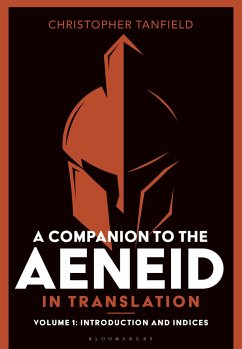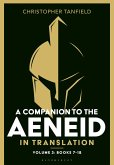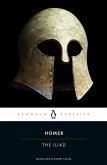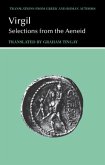Christopher Tanfield (Classics Teacher, Independent Scholar, UK)
A Companion to the Aeneid in Translation: Volume 1
Introduction and Indices
Christopher Tanfield (Classics Teacher, Independent Scholar, UK)
A Companion to the Aeneid in Translation: Volume 1
Introduction and Indices
- Broschiertes Buch
- Merkliste
- Auf die Merkliste
- Bewerten Bewerten
- Teilen
- Produkt teilen
- Produkterinnerung
- Produkterinnerung
The first guide for students to the Aeneid when read in translation; this volume contains a detailed contextual introduction and cross-edition index.
Andere Kunden interessierten sich auch für
![A Companion to the Aeneid in Translation: Volume 2 A Companion to the Aeneid in Translation: Volume 2]() Christopher Tanfield (Classics Teacher, Independent Scholar, UK)A Companion to the Aeneid in Translation: Volume 235,99 €
Christopher Tanfield (Classics Teacher, Independent Scholar, UK)A Companion to the Aeneid in Translation: Volume 235,99 €![A Companion to the Aeneid in Translation: Volume 3 A Companion to the Aeneid in Translation: Volume 3]() Christopher Tanfield (Classics Teacher, Independent Scholar, UK)A Companion to the Aeneid in Translation: Volume 335,99 €
Christopher Tanfield (Classics Teacher, Independent Scholar, UK)A Companion to the Aeneid in Translation: Volume 335,99 €![Virgil Aeneid IV: A Selection Virgil Aeneid IV: A Selection]() John Storey (Head of Classics, Downside School, UK)Virgil Aeneid IV: A Selection23,99 €
John Storey (Head of Classics, Downside School, UK)Virgil Aeneid IV: A Selection23,99 €![The Iliad The Iliad]() HomerThe Iliad19,99 €
HomerThe Iliad19,99 €![Virgil: Selections from the Aeneid Virgil: Selections from the Aeneid]() VirgilVirgil: Selections from the Aeneid27,99 €
VirgilVirgil: Selections from the Aeneid27,99 €![de Romanis Book 3 de Romanis Book 3]() Katharine Radice (UK University of Cambridge)de Romanis Book 327,99 €
Katharine Radice (UK University of Cambridge)de Romanis Book 327,99 €![Virgil Virgil]() Alison Keith (Canada University of Toronto)Virgil32,99 €
Alison Keith (Canada University of Toronto)Virgil32,99 €-
-
-
The first guide for students to the Aeneid when read in translation; this volume contains a detailed contextual introduction and cross-edition index.
Produktdetails
- Produktdetails
- Verlag: Bloomsbury Publishing PLC
- Seitenzahl: 304
- Erscheinungstermin: 3. April 2025
- Englisch
- Abmessung: 242mm x 168mm x 20mm
- Gewicht: 518g
- ISBN-13: 9781350499492
- ISBN-10: 1350499498
- Artikelnr.: 70165481
- Herstellerkennzeichnung
- Libri GmbH
- Europaallee 1
- 36244 Bad Hersfeld
- gpsr@libri.de
- Verlag: Bloomsbury Publishing PLC
- Seitenzahl: 304
- Erscheinungstermin: 3. April 2025
- Englisch
- Abmessung: 242mm x 168mm x 20mm
- Gewicht: 518g
- ISBN-13: 9781350499492
- ISBN-10: 1350499498
- Artikelnr.: 70165481
- Herstellerkennzeichnung
- Libri GmbH
- Europaallee 1
- 36244 Bad Hersfeld
- gpsr@libri.de
Christopher Tanfield has taught Classics for over twenty years and takes a keen interest in making the subject accessible as widely as possible. His publications include Cicero Philippic II: A Selection and Virgil Aeneid X: A Selection, both published by Bloomsbury.
Foreword
Preface
1. Historical background
1.1: Rome's Origins - Rival Traditions
1.2: Rome's Origins - Archaeology
1.3: From Aeneas to Romulus - the Alban Kings (to 753 BCE)
1.4: The Roman Kings (to 509 BCE)
1.5: The Early Republic (to 133 BCE)
1.6: The Late Republic (from 133 BCE onwards)
1.7: Augustus in the Aeneid
1.8: Literary Sources for Roman History
2. Virgil's Life and Works
2.1: Life
2.2: Virgilian Appendix.
2.3: Eclogues (or 'Bucolics')
2.4: Georgics6
2.5: A Planned Career?
3. Main characters
3.1: Characterisation in the Aeneid
3.2: Aeneas
3.3: Turnus
3.4: Dido
3.5: Ascanius
3.6: Anchises
3.7: Latinus and Evander
3.8: Amata
3.9: Lavinia
3.10: Camilla
4. The Gods and Fate
4.1: Greek Versus Roman Gods
4.2: Olympian Gods in Homer
4.3: Olympian Gods in the Aeneid
4.4: Fate
4.5: Gods in Particular
4.6: Gigantomachy
4.7: Orphism and Pythagoreanism
5. Philosophical background
5.1: Plato and the Academy (First Half of the Fourth Century BCE)
5.2: Aristotle and the Peripatetics (from the Late Fourth Century BCE)
5.3: Epicureanism - History
5.4: Stoicism - History
5.5: Stoicism, Epicureanism and the Aeneid
5.6: Cicero's Philosophical Writings
6. Society
6.1: Romanness
6.2: Family
6.3: Women - at Rome and in the Aeneid
6.4: Religion
6.5: Battles
7. Literary aspects
7.1: Structure
7.2: The Hero
7.3: Narratology
7.4: Ekphrasis
7.5: Similes
7.6: Speeches
7.7: Diction
7.8: Metre
8. Reading the Aeneid
8.1: Intratextuality - Self-Allusion
8.2: Intertextuality, Narrow Sense - External Allusion
8.3: Allusion and Subjectivity
8.4: Epic and other Literary Antecedents
9. Reception
9.1: The First 150 Years after Virgil
9.2: The Second to Fifth Centuries - Servius and Macrobius
9.3: The Middle Ages and Renaissance - Survival
9.4: 16th to 19th Centuries - Resurgence and Eclipse
9.5: 20th and 21st Centuries - Re-evaluation
9.6: Literary Theory
10. Translating the Aeneid (into English)
11. Maps
12. Family Tree of the Royal Houses of Greece and Troy
Notes
Select Bibliography
Index to the Introduction
Index to the Commentaries in Volumes 2 and 3
Preface
1. Historical background
1.1: Rome's Origins - Rival Traditions
1.2: Rome's Origins - Archaeology
1.3: From Aeneas to Romulus - the Alban Kings (to 753 BCE)
1.4: The Roman Kings (to 509 BCE)
1.5: The Early Republic (to 133 BCE)
1.6: The Late Republic (from 133 BCE onwards)
1.7: Augustus in the Aeneid
1.8: Literary Sources for Roman History
2. Virgil's Life and Works
2.1: Life
2.2: Virgilian Appendix.
2.3: Eclogues (or 'Bucolics')
2.4: Georgics6
2.5: A Planned Career?
3. Main characters
3.1: Characterisation in the Aeneid
3.2: Aeneas
3.3: Turnus
3.4: Dido
3.5: Ascanius
3.6: Anchises
3.7: Latinus and Evander
3.8: Amata
3.9: Lavinia
3.10: Camilla
4. The Gods and Fate
4.1: Greek Versus Roman Gods
4.2: Olympian Gods in Homer
4.3: Olympian Gods in the Aeneid
4.4: Fate
4.5: Gods in Particular
4.6: Gigantomachy
4.7: Orphism and Pythagoreanism
5. Philosophical background
5.1: Plato and the Academy (First Half of the Fourth Century BCE)
5.2: Aristotle and the Peripatetics (from the Late Fourth Century BCE)
5.3: Epicureanism - History
5.4: Stoicism - History
5.5: Stoicism, Epicureanism and the Aeneid
5.6: Cicero's Philosophical Writings
6. Society
6.1: Romanness
6.2: Family
6.3: Women - at Rome and in the Aeneid
6.4: Religion
6.5: Battles
7. Literary aspects
7.1: Structure
7.2: The Hero
7.3: Narratology
7.4: Ekphrasis
7.5: Similes
7.6: Speeches
7.7: Diction
7.8: Metre
8. Reading the Aeneid
8.1: Intratextuality - Self-Allusion
8.2: Intertextuality, Narrow Sense - External Allusion
8.3: Allusion and Subjectivity
8.4: Epic and other Literary Antecedents
9. Reception
9.1: The First 150 Years after Virgil
9.2: The Second to Fifth Centuries - Servius and Macrobius
9.3: The Middle Ages and Renaissance - Survival
9.4: 16th to 19th Centuries - Resurgence and Eclipse
9.5: 20th and 21st Centuries - Re-evaluation
9.6: Literary Theory
10. Translating the Aeneid (into English)
11. Maps
12. Family Tree of the Royal Houses of Greece and Troy
Notes
Select Bibliography
Index to the Introduction
Index to the Commentaries in Volumes 2 and 3
Foreword
Preface
1. Historical background
1.1: Rome's Origins - Rival Traditions
1.2: Rome's Origins - Archaeology
1.3: From Aeneas to Romulus - the Alban Kings (to 753 BCE)
1.4: The Roman Kings (to 509 BCE)
1.5: The Early Republic (to 133 BCE)
1.6: The Late Republic (from 133 BCE onwards)
1.7: Augustus in the Aeneid
1.8: Literary Sources for Roman History
2. Virgil's Life and Works
2.1: Life
2.2: Virgilian Appendix.
2.3: Eclogues (or 'Bucolics')
2.4: Georgics6
2.5: A Planned Career?
3. Main characters
3.1: Characterisation in the Aeneid
3.2: Aeneas
3.3: Turnus
3.4: Dido
3.5: Ascanius
3.6: Anchises
3.7: Latinus and Evander
3.8: Amata
3.9: Lavinia
3.10: Camilla
4. The Gods and Fate
4.1: Greek Versus Roman Gods
4.2: Olympian Gods in Homer
4.3: Olympian Gods in the Aeneid
4.4: Fate
4.5: Gods in Particular
4.6: Gigantomachy
4.7: Orphism and Pythagoreanism
5. Philosophical background
5.1: Plato and the Academy (First Half of the Fourth Century BCE)
5.2: Aristotle and the Peripatetics (from the Late Fourth Century BCE)
5.3: Epicureanism - History
5.4: Stoicism - History
5.5: Stoicism, Epicureanism and the Aeneid
5.6: Cicero's Philosophical Writings
6. Society
6.1: Romanness
6.2: Family
6.3: Women - at Rome and in the Aeneid
6.4: Religion
6.5: Battles
7. Literary aspects
7.1: Structure
7.2: The Hero
7.3: Narratology
7.4: Ekphrasis
7.5: Similes
7.6: Speeches
7.7: Diction
7.8: Metre
8. Reading the Aeneid
8.1: Intratextuality - Self-Allusion
8.2: Intertextuality, Narrow Sense - External Allusion
8.3: Allusion and Subjectivity
8.4: Epic and other Literary Antecedents
9. Reception
9.1: The First 150 Years after Virgil
9.2: The Second to Fifth Centuries - Servius and Macrobius
9.3: The Middle Ages and Renaissance - Survival
9.4: 16th to 19th Centuries - Resurgence and Eclipse
9.5: 20th and 21st Centuries - Re-evaluation
9.6: Literary Theory
10. Translating the Aeneid (into English)
11. Maps
12. Family Tree of the Royal Houses of Greece and Troy
Notes
Select Bibliography
Index to the Introduction
Index to the Commentaries in Volumes 2 and 3
Preface
1. Historical background
1.1: Rome's Origins - Rival Traditions
1.2: Rome's Origins - Archaeology
1.3: From Aeneas to Romulus - the Alban Kings (to 753 BCE)
1.4: The Roman Kings (to 509 BCE)
1.5: The Early Republic (to 133 BCE)
1.6: The Late Republic (from 133 BCE onwards)
1.7: Augustus in the Aeneid
1.8: Literary Sources for Roman History
2. Virgil's Life and Works
2.1: Life
2.2: Virgilian Appendix.
2.3: Eclogues (or 'Bucolics')
2.4: Georgics6
2.5: A Planned Career?
3. Main characters
3.1: Characterisation in the Aeneid
3.2: Aeneas
3.3: Turnus
3.4: Dido
3.5: Ascanius
3.6: Anchises
3.7: Latinus and Evander
3.8: Amata
3.9: Lavinia
3.10: Camilla
4. The Gods and Fate
4.1: Greek Versus Roman Gods
4.2: Olympian Gods in Homer
4.3: Olympian Gods in the Aeneid
4.4: Fate
4.5: Gods in Particular
4.6: Gigantomachy
4.7: Orphism and Pythagoreanism
5. Philosophical background
5.1: Plato and the Academy (First Half of the Fourth Century BCE)
5.2: Aristotle and the Peripatetics (from the Late Fourth Century BCE)
5.3: Epicureanism - History
5.4: Stoicism - History
5.5: Stoicism, Epicureanism and the Aeneid
5.6: Cicero's Philosophical Writings
6. Society
6.1: Romanness
6.2: Family
6.3: Women - at Rome and in the Aeneid
6.4: Religion
6.5: Battles
7. Literary aspects
7.1: Structure
7.2: The Hero
7.3: Narratology
7.4: Ekphrasis
7.5: Similes
7.6: Speeches
7.7: Diction
7.8: Metre
8. Reading the Aeneid
8.1: Intratextuality - Self-Allusion
8.2: Intertextuality, Narrow Sense - External Allusion
8.3: Allusion and Subjectivity
8.4: Epic and other Literary Antecedents
9. Reception
9.1: The First 150 Years after Virgil
9.2: The Second to Fifth Centuries - Servius and Macrobius
9.3: The Middle Ages and Renaissance - Survival
9.4: 16th to 19th Centuries - Resurgence and Eclipse
9.5: 20th and 21st Centuries - Re-evaluation
9.6: Literary Theory
10. Translating the Aeneid (into English)
11. Maps
12. Family Tree of the Royal Houses of Greece and Troy
Notes
Select Bibliography
Index to the Introduction
Index to the Commentaries in Volumes 2 and 3








